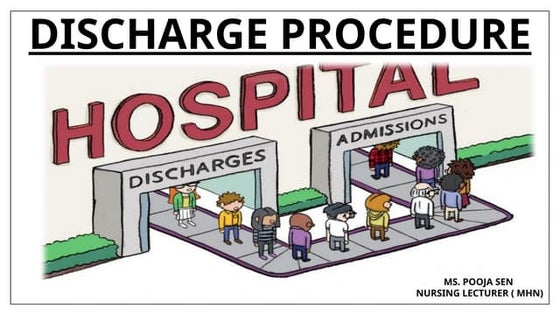Definition, Purpose, Rules and Techniques in Summarizing Academic Texts
13 likes11,997 views
This document defines summarization and provides rules and techniques for summarizing academic texts. Summarizing involves reducing the original text to one-third or one-quarter of its length while retaining the main ideas and meaning. The basic rules for summarizing are to eliminate unnecessary details, focus only on important points, remove repetitive information, use general terms instead of specifics, and write the summary in your own words. The document then outlines various techniques for summarizing such as outlining, using a story structure format like "Somebody Wanted But So Then", or focusing on the key questions of who, what, when, where, why, and how.
1 of 27









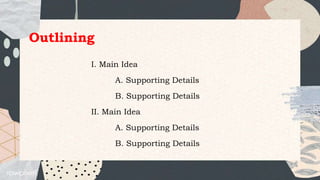

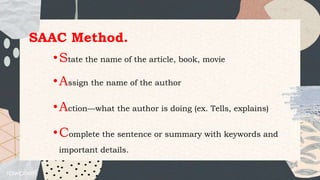


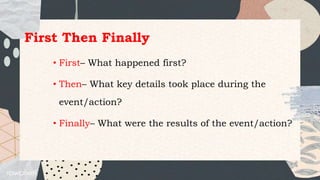












Recommended
-EAPP-Concept-Paper-ppt.ppt



-EAPP-Concept-Paper-ppt.pptmarivicfrancisco4
╠²
The document discusses writing a concept paper and provides guidance on its structure and components. It defines a concept paper as a paper that defines an idea or concept by explaining its essence to clarify what it is. It also lists the learning competencies for writing a concept paper, which include defining what a concept paper is, determining ways to elucidate a concept, identifying situations where a concept paper can be used, comprehending different types of concept papers, and presenting a novel concept or project with visual aids. The document provides examples and activities to help learners understand and write effective concept papers.VARIOUS TECHNIQUES IN SUMMARIZING A VARIETY OF ACADEMIC.pptx



VARIOUS TECHNIQUES IN SUMMARIZING A VARIETY OF ACADEMIC.pptxEazthaengDharlengLep
╠²
The document discusses various techniques for summarizing academic texts, including stating the main ideas and thesis clearly and concisely while retaining the key information. It provides examples of summarizing different types of texts using techniques like the "Somebody Wanted But So Then" method and the "5 W's and 1 H" approach. The document also emphasizes the importance of understanding the author's intent and meaning when summarizing.Copy of creative representation of literary text.pptx



Copy of creative representation of literary text.pptxMae Pangan
╠²
The document discusses having students creatively interpret a literary text using multimedia and ICT skills. It describes learning outcomes for students, including demonstrating understanding of anecdotes, interpreting anecdotes using appropriate multimedia formats, applying ICT skills to adapt a literary work, and appreciating how multimedia can creatively interpret literature. Various multimedia formats are defined that students could use, such as mind maps, mobile phone texts, slide shows, tag clouds, and videos.LESSON 1- Patterns of Development in Writing Across Disciplines.pptx



LESSON 1- Patterns of Development in Writing Across Disciplines.pptxRoselynGabat1
╠²
The document discusses different patterns of development in writing across disciplines. It begins by defining four common patterns: definition, exemplification, description, and comparison/contrast. Examples of each pattern are provided. Students then complete activities to practice identifying these patterns in sample texts and writing paragraphs using each pattern. The goals are to understand how written texts can be organized differently depending on purpose and to be able to analyze patterns used in various readings. Students are assigned to write one paragraph for each of the four patterns as homework.Q2_W1_Writing a Close Analysis and Critical Interpretation.pptx



Q2_W1_Writing a Close Analysis and Critical Interpretation.pptxMelvyEspanol1
╠²
The document discusses different reading approaches used to analyze and interpret literary texts, including extensive reading, scanning, and skimming. Extensive reading involves reading longer texts to improve knowledge, scanning means quickly reading texts to extract detailed information, and skimming means identifying the main idea of a text quickly. The document provides examples of how these approaches are used and teaches the differences between them.Uses knowledge of text structure to glean the information he/she needs



Uses knowledge of text structure to glean the information he/she needsMichelle390295
╠²
This document discusses different text structures and summarizing techniques. It describes common text structures like spatial/description, cause and effect, comparison and contrast, chronological order, and problem-solution. For each structure, it provides examples and explanations of how it organizes information. The document also discusses summarizing as condensing a lot of information into a short synopsis that touches on the main points. It offers methods for summarizing like using previewing techniques, including the thesis in the first sentence, and answering who, what, when, where, why and how. Finally, it states that summarizing is an important academic skill for note-taking and researching essays.Structures of academic text - EAPP



Structures of academic text - EAPPMariechris David
╠²
The document discusses the different structures used in academic texts. It identifies 9 main structures: definition, description, recount of sequence, cause and effect, comparison and contrast, enumeration, problem solution, classification, and thesis evidence. It provides examples of each structure and encourages learning activities where students apply the structures, such as describing a person, making a flow chart on a process, or providing a scenario where the structures could be used in studies. The overall purpose is to instruct readers on identifying and applying different text structures used in academic writing.USE KNOWLEDGE OF TEXT STRUCTURE TO GLEAN THE INFORMATION HE/SHE NEEDS.pptx



USE KNOWLEDGE OF TEXT STRUCTURE TO GLEAN THE INFORMATION HE/SHE NEEDS.pptxMikeeMagss
╠²
This document discusses the six general classifications of academic texts: essay, concept paper, reaction paper, position paper, report, and research. It provides definitions and examples for each classification. Essays exhibit a formal tone and can be considered academic. Concept papers define an idea or concept and clarify its meaning. Reaction papers provide a personal perspective on a given work. Position papers assert an argument and aim to convince the audience of a valid opinion. Reports retell data or events. Research involves highly formal reports.EAPP-WEEK-4-thesis-statements.pptx



EAPP-WEEK-4-thesis-statements.pptxMarichellAbande
╠²
This document provides information about thesis statements and summarizing skills. It defines what a thesis statement is and lists the key elements of a strong thesis statement. The document also discusses distinguishing weak from strong thesis statements. Additionally, it provides an activity to identify thesis statements and differentiates them from questions or announcements.Lesson on patterns of development



Lesson on patterns of developmentMelanio Florino
╠²
This document provides information on paragraph rhetoric models, including describing, defining, classification, compare/contrast, and cause and effect. It discusses how to write paragraphs using these models, with examples for each. Key details covered include using sensory details in descriptive paragraphs, extending dictionary definitions, organizing compare/contrast paragraphs in block or point-by-point format, and establishing direct and indirect causes and effects. The document also reviews patterns of development in writing like narration, description, definition, exemplification, and persuasion.Lesson 7 VARIOUS KINDS OF CONCEPT PAPER.pptx



Lesson 7 VARIOUS KINDS OF CONCEPT PAPER.pptxCathApostol1
╠²
The document compares and contrasts two types of concept papers: concept papers for projects and concept papers for academic research. It provides the typical parts and descriptions for each. Concept papers for projects typically include a cover page, introduction, rationale/background, project description, and project needs/cost. Concept papers for academic research typically include a title page, background, preliminary literature review, statement of problem/objectives, abridged methodology, timeline, and references. The document provides descriptions and purposes for each part to help writers understand how to structure different types of concept papers.Writing a reaction paper or review - EAPP



Writing a reaction paper or review - EAPPMariechris David
╠²
The document provides guidance on writing a reaction paper. It discusses the differences between a reaction paper and a diary entry. A reaction paper is meant for a broader societal audience, while a diary entry is personal. A reaction paper uses more formal language and rhetorical devices to inform readers and provide a measured response to an event or experience. It can help readers make decisions by providing reviews and perspectives. The document emphasizes that a well-written reaction paper can help people feel less alone and better understand how to navigate the world.Pattern and Properties of Written Text.pptx



Pattern and Properties of Written Text.pptxjerielcondrillon
╠²
This document provides an overview of reading and writing skills, including patterns and properties of written texts. It discusses 8 patterns of development for written texts: cause-effect, classification, comparison-contrast, definition, description, narration, persuasion, and problem-solution. It also outlines 4 key properties of written texts: organization, coherence, cohesion, language use, and language mechanics. Specific elements are described for each pattern and property, such as common signal words, text structure, punctuation, spelling, and capitalization guidelines. The document is intended to teach students how to analyze and understand different types of written works.Differentiating 21st Century Literary Genres from Early Literary.pptx



Differentiating 21st Century Literary Genres from Early Literary.pptxjullyannfullo1
╠²
This document provides an overview of 21st century literature and compares it to earlier literary periods. It begins by listing four learning objectives related to identifying major 21st century literary genres, differentiating them from earlier genres, and analyzing themes and elements. The document then defines key literary terms like tone, rhythm, climax, and defines the two main divisions of literature - prose and poetry. It provides examples of each and lists elements and types of poetry. The purpose is to help the reader understand 21st century literature in the context of literary history.GRAPHIC-FICTION-VS-FLASH-FICTION.pptx



GRAPHIC-FICTION-VS-FLASH-FICTION.pptxLawrenceBenito
╠²
The document discusses and differentiates several 21st century literary genres:
- Text-talk novels tell stories through social media dialogue. Digi-fiction combines books, movies, and websites to tell a story across multiple media platforms. Illustrated novels are 50% narrative and 50% illustrations with little words. Chicklit is a humorous fictional genre about modern womanhood issues. Manga refers to comic books originally published in Japan.
The document then provides more details about graphic fiction and flash fiction genres. Graphic fiction combines words and illustrations in sequenced image panels to tell a comic book style narrative equivalent to a prose novel. Flash fiction is extremely brief fiction ranging from a single word to 1,000 words that emphasizes plot developmentCreative Nonfiction Module 3



Creative Nonfiction Module 3Irineo L. Santiago NHS MD
╠²
Creative nonfiction incorporates elements of both fiction and nonfiction. It uses literary techniques to create factual narratives. Some key elements include:
1. Plot - The sequence of events.
2. Setting and atmosphere - The time, place, and details that provide context.
3. Characters - Real people described with traits and histories.
Creative nonfiction aims to inform and engage readers using techniques like imagery, symbolism, dialogue and point of view normally seen in fiction.EAPP first lesson



EAPP first lessonMariechris David
╠²
This document discusses academic writing. It defines academic writing as a formal, objective writing style that uses deductive reasoning to present concepts and ideas about a specific topic through a scholarly process. The document distinguishes academic writing from other types of writing and identifies its purpose, audience, language, and style. It provides examples of different types of academic writing like literary analysis, research papers, and dissertations. The document also discusses key areas of academic writing like content, structure, language, and mechanics.types of creative nonfiction.pptx



types of creative nonfiction.pptxJaniceGacula1
╠²
This document defines and provides examples of different forms of creative nonfiction, including autobiography, biography, memoir, reflective essay, and exposition. It discusses the key characteristics of each form. For example, it states that an autobiography is a self-written life story, while a biography is the life story of another person written by someone else. It provides examples of each form. The document is intended to teach students about different types of creative nonfiction writing.Forming opinions based on facts - EAPP



Forming opinions based on facts - EAPPMariechris David
╠²
The document discusses the difference between facts and opinions. It provides examples of facts, such as "Pizza is a type of food" and "Mount St. Helens erupted in 1980", which can be proven true or false. In contrast, opinions express personal beliefs that cannot be proven, like "Pepperoni pizza is delicious" and "Everyone should visit Mount St. Helens." The document emphasizes the importance of distinguishing facts from opinions to make intelligent judgements. It then provides a practice activity where readers determine whether sentences describe facts or opinions.EAPP TECHNIQUES IN SUMMARIZING A VARIETY OF ACADEMIC TEXT.pptx



EAPP TECHNIQUES IN SUMMARIZING A VARIETY OF ACADEMIC TEXT.pptxDIOMEDISPOLLESCAS
╠²
Summarizing is the process of condensing a longer piece of text or a complex idea into a concise and coherent summary. It involves capturing the main points, key details, and essential information while omitting unnecessary details or examples. Summarizing is an important skill in academic and professional settings as it allows for the efficient communication of information and understanding of a text's central ideas without having to read or present the entire content.
Lesson-5-Properties-of-a-well-written-text.pptx



Lesson-5-Properties-of-a-well-written-text.pptxAicySchleyEsmalde
╠²
The document provides information on the key properties of a well-written text, including organization, coherence and cohesion, unity, language use, mechanics, and proofreading. It discusses the importance of structure, logical flow of ideas, consistent tone, appropriate word choices, well-crafted sentences, and clarity. Various elements that ensure these properties are achieved are also described such as different organizational structures, techniques for coherence, principles of language use, mechanics guidelines, and the proofreading process.EAPP-Lesson-2 W1.pptx



EAPP-Lesson-2 W1.pptxJOLLIBEETORRES2
╠²
This document outlines learning objectives for a week of lessons. The objectives are to differentiate between academic language from different disciplines; determine the structure of academic texts; explain ideas in academic texts; use text structure to extract needed information; and use techniques to summarize a variety of academic texts. It also provides examples of text structures like comparison, cause and effect, problem-solution, chronological, and descriptive.CREATIVE WRITING



CREATIVE WRITINGLeah Condina
╠²
Creative writing differs from technical writing in several key ways. Creative writing is fictional in nature, such as poetry, novels and short stories, and allows for more personal expression and imagination. It does not need to adhere to strict guidelines. Technical writing conveys factual information to a specific audience for a specific purpose in an objective manner according to guidelines. Creative writing aims to entertain through techniques like character development and vivid descriptions that engage the senses, while technical writing focuses on informing through specialized vocabulary and facts.Sdo navotas creative_writing_q2_m4_explore different staging modalities vis-a...



Sdo navotas creative_writing_q2_m4_explore different staging modalities vis-a...DepEd Navotas
╠²
Here are the similarities and differences between the two scripts:
Similarities:
- Both are scripts for plays/dramas
- Both include descriptions of the setting/locations
- Both include information about the number and types of characters
Differences:
- Script A is from the movie 1917 while Script B is an original one act American drama script
- Script A does not include character descriptions while Script B provides some details about the ages and roles of the characters
- Script A seems to be a scene from a larger work while Script B is a self-contained one act play
- Script A does not provide information about length or difficulty level while Script B includes estimates for length and level of difficulty for the set
-Text as a connected discourse



Text as a connected discourseAndre Philip Tacderas
╠²
This document discusses the properties of well-written texts and techniques for organizing information. It identifies organization, coherence, cohesion, appropriate language use, and proper mechanics as key properties. Organization refers to arranging ideas in an introduction, body, and conclusion. Coherence is achieved through connections between ideas, while cohesion uses transitional words. Graphic organizers and outlining are presented as techniques to arrange ideas hierarchically and show relationships between them. Common patterns of development like narration and description are also discussed.Literature texts and contexts 1



Literature texts and contexts 1The Mackay School
╠²
This document discusses the importance of considering context when analyzing literary texts. It defines context as the circumstances surrounding a text that help specify its meaning, such as historical, cultural, and social factors. Understanding context is important because external forces influence how works are received and understood. However, determining what contextual information is necessary can be difficult. The document also notes that readers are part of the context, as their experiences and biases shape how meaning is communicated. Key aspects of context include the author's life and times, as well as broader cultural, political, and aesthetic concerns of the period.Nature of academic texts



Nature of academic textsAngelica Pabillar
╠²
Here are the 4 texts with my assessment of whether they are academic or non-academic:
1. Textbook - Academic
Textbooks are written by subject matter experts for educational purposes. They contain formal language, references, and are edited for accuracy.
2. Short student essay - Academic
While shorter than a dissertation, a student essay is still an academic work if it was written to fulfill an educational requirement. It will cite sources and use appropriate formatting.
3. Long dissertation - Academic
A dissertation requires extensive research and is intended to advance knowledge in its field. It will be formally written with sources cited.
4. News article - Non-academic
A news article is intended for public consumptionCreative Nonfiction Module 2.pdf



Creative Nonfiction Module 2.pdfIrineo L. Santiago NHS MD
╠²
The document discusses creative nonfiction as a genre that incorporates elements of fiction into nonfiction writing by using one's personal experiences, real people, or actual events as topics. It lists various literary elements commonly used in creative nonfiction such as characters, setting, plot, dialogue, imagery, point of view, and theme. Examples of these elements are also provided to illustrate how creative nonfiction utilizes techniques from both fiction and nonfiction writing.How to write essays



How to write essaysLorena Chum
╠²
The document provides guidance on writing different types of essays. It explains the typical parts of an essay including the introduction, supporting paragraphs, and summary paragraph. It then describes how to write each part, with examples. Specific types of essays are defined, like definition, classification, description, compare/contrast, and evaluation essays. For each type, it gives the structure and provides an example topic.Essay Writing 



Essay Writing Self-employed
╠²
This document provides guidance on writing different types of essays. It discusses analyzing the topic, outlining an introduction paragraph with a thesis statement, and using supporting paragraphs with facts and examples. It also covers prewriting steps like collecting facts and ideas, finding the main idea, and organizing the essay. Editing steps include checking grammar, spelling, style, and organization. Finally, it defines and provides examples of definition, classification, description, and compare/contrast essays.More Related Content
What's hot (20)
EAPP-WEEK-4-thesis-statements.pptx



EAPP-WEEK-4-thesis-statements.pptxMarichellAbande
╠²
This document provides information about thesis statements and summarizing skills. It defines what a thesis statement is and lists the key elements of a strong thesis statement. The document also discusses distinguishing weak from strong thesis statements. Additionally, it provides an activity to identify thesis statements and differentiates them from questions or announcements.Lesson on patterns of development



Lesson on patterns of developmentMelanio Florino
╠²
This document provides information on paragraph rhetoric models, including describing, defining, classification, compare/contrast, and cause and effect. It discusses how to write paragraphs using these models, with examples for each. Key details covered include using sensory details in descriptive paragraphs, extending dictionary definitions, organizing compare/contrast paragraphs in block or point-by-point format, and establishing direct and indirect causes and effects. The document also reviews patterns of development in writing like narration, description, definition, exemplification, and persuasion.Lesson 7 VARIOUS KINDS OF CONCEPT PAPER.pptx



Lesson 7 VARIOUS KINDS OF CONCEPT PAPER.pptxCathApostol1
╠²
The document compares and contrasts two types of concept papers: concept papers for projects and concept papers for academic research. It provides the typical parts and descriptions for each. Concept papers for projects typically include a cover page, introduction, rationale/background, project description, and project needs/cost. Concept papers for academic research typically include a title page, background, preliminary literature review, statement of problem/objectives, abridged methodology, timeline, and references. The document provides descriptions and purposes for each part to help writers understand how to structure different types of concept papers.Writing a reaction paper or review - EAPP



Writing a reaction paper or review - EAPPMariechris David
╠²
The document provides guidance on writing a reaction paper. It discusses the differences between a reaction paper and a diary entry. A reaction paper is meant for a broader societal audience, while a diary entry is personal. A reaction paper uses more formal language and rhetorical devices to inform readers and provide a measured response to an event or experience. It can help readers make decisions by providing reviews and perspectives. The document emphasizes that a well-written reaction paper can help people feel less alone and better understand how to navigate the world.Pattern and Properties of Written Text.pptx



Pattern and Properties of Written Text.pptxjerielcondrillon
╠²
This document provides an overview of reading and writing skills, including patterns and properties of written texts. It discusses 8 patterns of development for written texts: cause-effect, classification, comparison-contrast, definition, description, narration, persuasion, and problem-solution. It also outlines 4 key properties of written texts: organization, coherence, cohesion, language use, and language mechanics. Specific elements are described for each pattern and property, such as common signal words, text structure, punctuation, spelling, and capitalization guidelines. The document is intended to teach students how to analyze and understand different types of written works.Differentiating 21st Century Literary Genres from Early Literary.pptx



Differentiating 21st Century Literary Genres from Early Literary.pptxjullyannfullo1
╠²
This document provides an overview of 21st century literature and compares it to earlier literary periods. It begins by listing four learning objectives related to identifying major 21st century literary genres, differentiating them from earlier genres, and analyzing themes and elements. The document then defines key literary terms like tone, rhythm, climax, and defines the two main divisions of literature - prose and poetry. It provides examples of each and lists elements and types of poetry. The purpose is to help the reader understand 21st century literature in the context of literary history.GRAPHIC-FICTION-VS-FLASH-FICTION.pptx



GRAPHIC-FICTION-VS-FLASH-FICTION.pptxLawrenceBenito
╠²
The document discusses and differentiates several 21st century literary genres:
- Text-talk novels tell stories through social media dialogue. Digi-fiction combines books, movies, and websites to tell a story across multiple media platforms. Illustrated novels are 50% narrative and 50% illustrations with little words. Chicklit is a humorous fictional genre about modern womanhood issues. Manga refers to comic books originally published in Japan.
The document then provides more details about graphic fiction and flash fiction genres. Graphic fiction combines words and illustrations in sequenced image panels to tell a comic book style narrative equivalent to a prose novel. Flash fiction is extremely brief fiction ranging from a single word to 1,000 words that emphasizes plot developmentCreative Nonfiction Module 3



Creative Nonfiction Module 3Irineo L. Santiago NHS MD
╠²
Creative nonfiction incorporates elements of both fiction and nonfiction. It uses literary techniques to create factual narratives. Some key elements include:
1. Plot - The sequence of events.
2. Setting and atmosphere - The time, place, and details that provide context.
3. Characters - Real people described with traits and histories.
Creative nonfiction aims to inform and engage readers using techniques like imagery, symbolism, dialogue and point of view normally seen in fiction.EAPP first lesson



EAPP first lessonMariechris David
╠²
This document discusses academic writing. It defines academic writing as a formal, objective writing style that uses deductive reasoning to present concepts and ideas about a specific topic through a scholarly process. The document distinguishes academic writing from other types of writing and identifies its purpose, audience, language, and style. It provides examples of different types of academic writing like literary analysis, research papers, and dissertations. The document also discusses key areas of academic writing like content, structure, language, and mechanics.types of creative nonfiction.pptx



types of creative nonfiction.pptxJaniceGacula1
╠²
This document defines and provides examples of different forms of creative nonfiction, including autobiography, biography, memoir, reflective essay, and exposition. It discusses the key characteristics of each form. For example, it states that an autobiography is a self-written life story, while a biography is the life story of another person written by someone else. It provides examples of each form. The document is intended to teach students about different types of creative nonfiction writing.Forming opinions based on facts - EAPP



Forming opinions based on facts - EAPPMariechris David
╠²
The document discusses the difference between facts and opinions. It provides examples of facts, such as "Pizza is a type of food" and "Mount St. Helens erupted in 1980", which can be proven true or false. In contrast, opinions express personal beliefs that cannot be proven, like "Pepperoni pizza is delicious" and "Everyone should visit Mount St. Helens." The document emphasizes the importance of distinguishing facts from opinions to make intelligent judgements. It then provides a practice activity where readers determine whether sentences describe facts or opinions.EAPP TECHNIQUES IN SUMMARIZING A VARIETY OF ACADEMIC TEXT.pptx



EAPP TECHNIQUES IN SUMMARIZING A VARIETY OF ACADEMIC TEXT.pptxDIOMEDISPOLLESCAS
╠²
Summarizing is the process of condensing a longer piece of text or a complex idea into a concise and coherent summary. It involves capturing the main points, key details, and essential information while omitting unnecessary details or examples. Summarizing is an important skill in academic and professional settings as it allows for the efficient communication of information and understanding of a text's central ideas without having to read or present the entire content.
Lesson-5-Properties-of-a-well-written-text.pptx



Lesson-5-Properties-of-a-well-written-text.pptxAicySchleyEsmalde
╠²
The document provides information on the key properties of a well-written text, including organization, coherence and cohesion, unity, language use, mechanics, and proofreading. It discusses the importance of structure, logical flow of ideas, consistent tone, appropriate word choices, well-crafted sentences, and clarity. Various elements that ensure these properties are achieved are also described such as different organizational structures, techniques for coherence, principles of language use, mechanics guidelines, and the proofreading process.EAPP-Lesson-2 W1.pptx



EAPP-Lesson-2 W1.pptxJOLLIBEETORRES2
╠²
This document outlines learning objectives for a week of lessons. The objectives are to differentiate between academic language from different disciplines; determine the structure of academic texts; explain ideas in academic texts; use text structure to extract needed information; and use techniques to summarize a variety of academic texts. It also provides examples of text structures like comparison, cause and effect, problem-solution, chronological, and descriptive.CREATIVE WRITING



CREATIVE WRITINGLeah Condina
╠²
Creative writing differs from technical writing in several key ways. Creative writing is fictional in nature, such as poetry, novels and short stories, and allows for more personal expression and imagination. It does not need to adhere to strict guidelines. Technical writing conveys factual information to a specific audience for a specific purpose in an objective manner according to guidelines. Creative writing aims to entertain through techniques like character development and vivid descriptions that engage the senses, while technical writing focuses on informing through specialized vocabulary and facts.Sdo navotas creative_writing_q2_m4_explore different staging modalities vis-a...



Sdo navotas creative_writing_q2_m4_explore different staging modalities vis-a...DepEd Navotas
╠²
Here are the similarities and differences between the two scripts:
Similarities:
- Both are scripts for plays/dramas
- Both include descriptions of the setting/locations
- Both include information about the number and types of characters
Differences:
- Script A is from the movie 1917 while Script B is an original one act American drama script
- Script A does not include character descriptions while Script B provides some details about the ages and roles of the characters
- Script A seems to be a scene from a larger work while Script B is a self-contained one act play
- Script A does not provide information about length or difficulty level while Script B includes estimates for length and level of difficulty for the set
-Text as a connected discourse



Text as a connected discourseAndre Philip Tacderas
╠²
This document discusses the properties of well-written texts and techniques for organizing information. It identifies organization, coherence, cohesion, appropriate language use, and proper mechanics as key properties. Organization refers to arranging ideas in an introduction, body, and conclusion. Coherence is achieved through connections between ideas, while cohesion uses transitional words. Graphic organizers and outlining are presented as techniques to arrange ideas hierarchically and show relationships between them. Common patterns of development like narration and description are also discussed.Literature texts and contexts 1



Literature texts and contexts 1The Mackay School
╠²
This document discusses the importance of considering context when analyzing literary texts. It defines context as the circumstances surrounding a text that help specify its meaning, such as historical, cultural, and social factors. Understanding context is important because external forces influence how works are received and understood. However, determining what contextual information is necessary can be difficult. The document also notes that readers are part of the context, as their experiences and biases shape how meaning is communicated. Key aspects of context include the author's life and times, as well as broader cultural, political, and aesthetic concerns of the period.Nature of academic texts



Nature of academic textsAngelica Pabillar
╠²
Here are the 4 texts with my assessment of whether they are academic or non-academic:
1. Textbook - Academic
Textbooks are written by subject matter experts for educational purposes. They contain formal language, references, and are edited for accuracy.
2. Short student essay - Academic
While shorter than a dissertation, a student essay is still an academic work if it was written to fulfill an educational requirement. It will cite sources and use appropriate formatting.
3. Long dissertation - Academic
A dissertation requires extensive research and is intended to advance knowledge in its field. It will be formally written with sources cited.
4. News article - Non-academic
A news article is intended for public consumptionCreative Nonfiction Module 2.pdf



Creative Nonfiction Module 2.pdfIrineo L. Santiago NHS MD
╠²
The document discusses creative nonfiction as a genre that incorporates elements of fiction into nonfiction writing by using one's personal experiences, real people, or actual events as topics. It lists various literary elements commonly used in creative nonfiction such as characters, setting, plot, dialogue, imagery, point of view, and theme. Examples of these elements are also provided to illustrate how creative nonfiction utilizes techniques from both fiction and nonfiction writing.Similar to Definition, Purpose, Rules and Techniques in Summarizing Academic Texts (20)
How to write essays



How to write essaysLorena Chum
╠²
The document provides guidance on writing different types of essays. It explains the typical parts of an essay including the introduction, supporting paragraphs, and summary paragraph. It then describes how to write each part, with examples. Specific types of essays are defined, like definition, classification, description, compare/contrast, and evaluation essays. For each type, it gives the structure and provides an example topic.Essay Writing 



Essay Writing Self-employed
╠²
This document provides guidance on writing different types of essays. It discusses analyzing the topic, outlining an introduction paragraph with a thesis statement, and using supporting paragraphs with facts and examples. It also covers prewriting steps like collecting facts and ideas, finding the main idea, and organizing the essay. Editing steps include checking grammar, spelling, style, and organization. Finally, it defines and provides examples of definition, classification, description, and compare/contrast essays.How to write a Summary effectively. Examples and practice



How to write a Summary effectively. Examples and practiceJillRuiz8
╠²
How to write a Summary effectively. Examples and practice Academic writing - essays.ppt



Academic writing - essays.pptPreciousChanaiwa
╠²
This document provides guidance on writing academic assignments. It discusses the typical structure of assignments, which usually includes an introduction, body, and conclusion. The introduction should introduce the topic, purpose, and overall argument or thesis. The body should have multiple paragraphs, each with a topic sentence followed by supporting evidence. The conclusion should summarize the main points and relate them back to the overall argument or question. The document also provides tips for analyzing the assignment title, keywords commonly used in titles, and a checklist for ensuring an assignment is well-written.Review of Section A of CAPE Communication Studies Essay Paper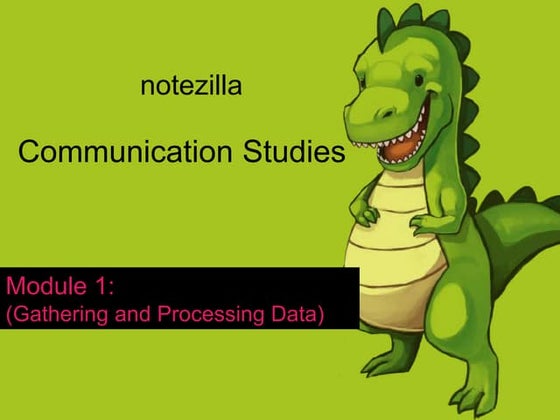



Review of Section A of CAPE Communication Studies Essay PaperNotezilla
╠²
Review of Section A of CAPE Communication Studies Essay Paper
check out http://notezil.la/ for more CAPE notes and resources! Media Assignment Feedback 2013



Media Assignment Feedback 2013Amanda Simmons
╠²
This document provides guidance on correctly submitting assignments and common issues to avoid. It emphasizes including a completed top sheet with key information stapled to the essay, appending a word count, using correct formatting and checking for errors. Recurrent problems identified are lack of depth, overuse of description rather than analysis, and failing to apply appropriate concepts. The document then defines important semiotic terms like signifier, signified, denoted and connoted needed to analyze texts. It provides an example of deconstructing an advertisement by identifying signifiers and their signified meanings and associations. Finally, it outlines the proper structure for essays with introduction, main body, conclusion, and references.Essay and Its Parts



Essay and Its PartsJobe Canenet
╠²
This document defines an essay and its typical parts. An essay is generally a short piece of writing from an author's personal perspective on a subject. It includes an introduction paragraph that states the main idea and provides context. Supporting paragraphs then develop the main idea with examples and details. Transition words link the paragraphs. A summary paragraph at the end restates the strongest supporting points and concludes by restating the main idea.Guideline to composition writing



Guideline to composition writingEponI
╠²
The document provides guidelines for composition writing for B1/B2/C1 level classes. It discusses the key parts of a composition, including the introduction, supporting paragraphs, and summary paragraph. It also covers pre-writing steps such as brainstorming, outlining, and organizing ideas. The document describes editing for grammar, style, and organization. Finally, it discusses different types of essays like descriptive and discursive, and provides useful phrases for essay writing.So, you have to write a research



So, you have to write a researchkealyduke
╠²
The document provides guidance on developing a thesis statement and outline for a research paper. It explains that a thesis should be clear, specific, debatable, and indicate what will be discussed in the paper. An outline helps organize ideas and discover relationships between information. It should include the main ideas and subpoints in a logical order. When drafting the paper, write deliberately based on the outline and embed quotes properly by framing them and indicating the source.Writing advice 1



Writing advice 1Karina Ambriz
╠²
This document provides advice on various aspects of academic writing such as essay structure, thesis statements, paragraph structure, and use of sources. It emphasizes that essays should have a clear argument supported by evidence. Good writing practices include starting early, outlining, and revising. When using sources, direct quotations should be limited and paraphrasing or summarizing is often better. The document also covers topics such as understanding essay topics, writing introductions and conclusions, comparing items in a comparative essay, and revising for clarity and organization.Lecture 7



Lecture 7GantsetsegS
╠²
This document provides guidance on summarizing process diagrams for the Academic Writing Task 1. It advises analyzing the task and diagram to identify the stages and order of the process. Descriptions should be written in paragraphs with the stages presented in sequential order, using passive voice and sequencing words to connect each step. Key details are to focus on the activities rather than people, begin with an overview, and utilize time connectors to flow clearly from start to finish of the process.TECHNIQUES IN SUMMARIZING VARIETY OF TEXT STRUCTURE.pptx



TECHNIQUES IN SUMMARIZING VARIETY OF TEXT STRUCTURE.pptxevafecampanado1
╠²
The document provides instruction on techniques for summarizing a variety of academic texts. It discusses opening with a prayer, recalling common text structures from previous lessons, and strategies for retelling stories from memory using one's own words. The document then defines summarization as reducing a larger work to its main ideas and essential details. It outlines basic rules for summarizing, including removing unnecessary information, redundant details, specific names, and rewriting in one's own words. Several summarization techniques are presented, such as "Somebody Wanted But So Then" to find main ideas and causality, the "SAAC Method" stating the title, author and action, and the "5 W's, 1 H" addressing who, what132. Essay writing



132. Essay writingLAKSHMANAN S
╠²
This document provides guidance on writing essays. It discusses what an essay is, how to outline and structure an essay, and the steps to writing an essay. The key points covered include:
- An essay is a written collection of organized paragraphs that clearly communicates an idea.
- Outlining an essay involves analyzing the topic or question, mind mapping key ideas, developing a case study or main example, and creating a paragraph plan with an introduction, body, and conclusion.
- The steps to writing an essay are to study the topic following an outline or study plan, develop a draft with an introduction, body paragraphs supporting the main idea, and a conclusion. The essay should then be organized, reviewed, andGlobal warming Introduction paragraph.pptx



Global warming Introduction paragraph.pptxshoukie76
╠²
An Introduction on how to write an essay on Global warming, breaking it into stepsWriting a Critique.pptx



Writing a Critique.pptxANGELIECRISTINEPOMAD1
╠²
A critique is a careful analysis of an argument or work to determine its key points, assumptions, issues overlooked, and implications. It involves a systematic yet personal evaluation of what was read. Writing a critique helps understand the work's purpose, audience, argument development, evidence structure, or creative style. To write a critique, one must thoroughly understand the work, take notes on important parts, and consider the work's main argument or purpose and how it relates to broader issues. A critique template includes an introduction naming the work and creator, a body analyzing the work using questions about its nature, objectives, design, assumptions, and biases, and a conclusion.English Composition Lecture Powerpoint.pptx



English Composition Lecture Powerpoint.pptxoliviawest18
╠²
Here are a few issues I see with this outline:
- The thesis/main point is not clearly stated. It's unclear if the writer is arguing cellphones do or do not cause problems.
- The subpoints under I and II are not parallel. One includes a cause and effect while the other just states a problem.
- Some points are not fully developed (e.g. "Cellphones cause more people to need glasses" lacks support/explanation).
- Grammar and spelling errors make some points unclear ("cellphones can develop addictions" and "rewire the b").
- No conclusion is included to wrap up the argument.
Overall, this outline would benefit from clarifying the thesis16 Essay Orgil



16 Essay OrgilBayarmaa GBayarmaa
╠²
The document discusses how to write an essay, including the key parts and stages of essay writing. It covers the introduction paragraph, supporting paragraphs, summary paragraph, and prewriting, writing, editing, and publishing stages. It provides examples of different types of essays such as definition, classification, description, compare and contrast, sequence, choice, explanation, and evaluation essays.Advice academic writing



Advice academic writingErica Gisela Delgado
╠²
This document provides guidance on various aspects of academic writing such as understanding essay topics, organizing an essay, reading and researching, using sources, revising writing, and specific types of writing. It discusses key elements like introductions, conclusions, paragraphs, topic sentences, taking notes, paraphrasing, summarizing, and identifying and fixing sentence fragments. The document aims to offer students advice to improve their academic writing skills.EAPP-LESSON-4.pptx



EAPP-LESSON-4.pptxAjAbraham5
╠²
This document provides an overview of summarization techniques for academic texts. It defines summarization as condensing a document into its main ideas and most important facts in a short form while retaining the author's meaning. The document then lists various techniques for summarizing, including identifying the author's intent, using visual aids to represent information, focusing on main points and excluding minor details, analyzing the text, restating ideas in your own words, and representing concepts through dimensional constructions. It also provides examples of summarizing frameworks like "Somebody Wanted But So Then", "SAAC Method", "5 W's and 1 H", "First Then Finally", and "Give Me the Gist". Finally, it discusses how summarization isAdviceonacademicwriting oliveramelany111-210525235841



Adviceonacademicwriting oliveramelany111-210525235841melanysolangeolivera
╠²
This document provides advice on various aspects of academic writing such as summarizing, avoiding plagiarism, using quotations and paraphrases, organizing essays, writing introductions and conclusions, and using topic sentences. It emphasizes that essays should have a clear argument or thesis, and notes some key elements of introductions, paragraphs, and conclusions. Transitions, diction, and economy in writing are also discussed.Recently uploaded (20)
Interim Guidelines for PMES-DM-17-2025-PPT.pptx



Interim Guidelines for PMES-DM-17-2025-PPT.pptxsirjeromemanansala
╠²
This is the latest issuance on PMES as replacement of RPMS. Kindly message me to gain full access of the presentation. Bß╗ś TEST KIß╗éM TRA GIß╗«A K├ī 2 - TIß║ŠNG ANH 10,11,12 - CHUß║©N FORM 2025 - GLOBAL SU...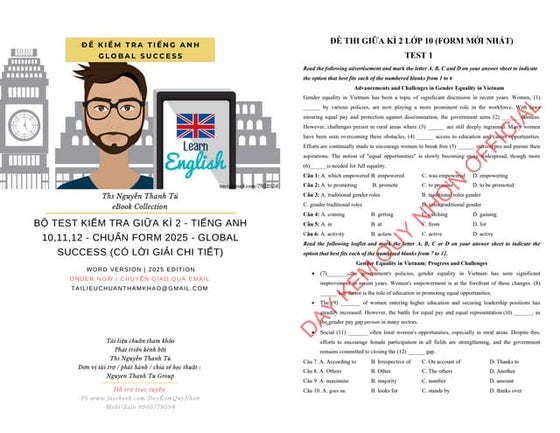



Bß╗ś TEST KIß╗éM TRA GIß╗«A K├ī 2 - TIß║ŠNG ANH 10,11,12 - CHUß║©N FORM 2025 - GLOBAL SU...Nguyen Thanh Tu Collection
╠²
https://app.box.com/s/ij1ty3vm7el9i4qfrr41o756xycbahmgChapter 2. Strategic Management: Corporate Governance.pdf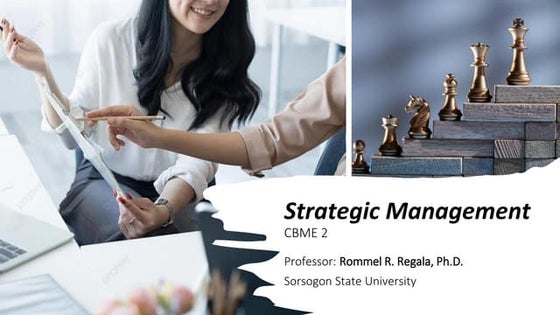



Chapter 2. Strategic Management: Corporate Governance.pdfRommel Regala
╠²
This course provides students with a comprehensive understanding of strategic management principles, frameworks, and applications in business. It explores strategic planning, environmental analysis, corporate governance, business ethics, and sustainability. The course integrates Sustainable Development Goals (SDGs) to enhance global and ethical perspectives in decision-making.How to Configure Proforma Invoice in Odoo 18 Sales



How to Configure Proforma Invoice in Odoo 18 SalesCeline George
╠²
In this slide, weŌĆÖll discuss on how to configure proforma invoice in Odoo 18 Sales module. A proforma invoice is a preliminary invoice that serves as a commercial document issued by a seller to a buyer.BISNIS BERKAH BERANGKAT KE MEKKAH ISTIKMAL SYARIAH



BISNIS BERKAH BERANGKAT KE MEKKAH ISTIKMAL SYARIAHcoacharyasetiyaki
╠²
BISNIS BERKAH BERANGKAT KE MEKKAH ISTIKMAL SYARIAHASP.NET Web API Interview Questions By Scholarhat



ASP.NET Web API Interview Questions By ScholarhatScholarhat
╠²
ASP.NET Web API Interview Questions By ScholarhatUnit 1 Computer Hardware for Educational Computing.pptx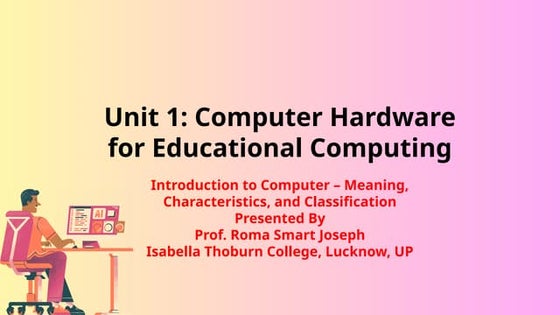



Unit 1 Computer Hardware for Educational Computing.pptxRomaSmart1
╠²
Computers have revolutionized various sectors, including education, by enhancing learning experiences and making information more accessible. This presentation, "Computer Hardware for Educational Computing," introduces the fundamental aspects of computers, including their definition, characteristics, classification, and significance in the educational domain. Understanding these concepts helps educators and students leverage technology for more effective learning.Oral exam Kenneth Bech - What is the meaning of strategic fit?



Oral exam Kenneth Bech - What is the meaning of strategic fit?MIPLM
╠²
Presentation of the CEIPI DU IPBA oral exam of Kenneth Bech - What is the meaning of strategic fit? Functional Muscle Testing of Facial Muscles.pdf



Functional Muscle Testing of Facial Muscles.pdfSamarHosni3
╠²
Functional Muscle Testing of Facial Muscles.pdfOdoo 18 Accounting Access Rights - Odoo 18 ║▌║▌▀Żs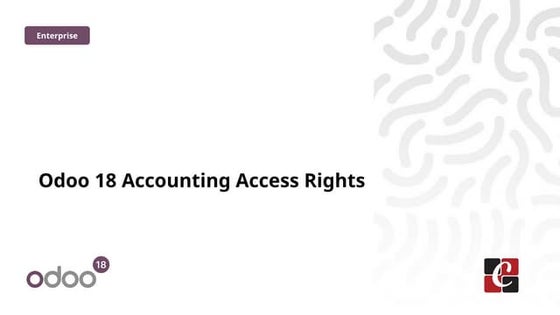



Odoo 18 Accounting Access Rights - Odoo 18 ║▌║▌▀ŻsCeline George
╠²
In this slide, weŌĆÖll discuss on accounting access rights in odoo 18. To ensure data security and maintain confidentiality, Odoo provides a robust access rights system that allows administrators to control who can access and modify accounting data. Full-Stack .NET Developer Interview Questions PDF By ScholarHat



Full-Stack .NET Developer Interview Questions PDF By ScholarHatScholarhat
╠²
Full-Stack .NET Developer Interview Questions PDF By ScholarHatDot NET Core Interview Questions PDF By ScholarHat



Dot NET Core Interview Questions PDF By ScholarHatScholarhat
╠²
Dot NET Core Interview Questions PDF By ScholarHatYear 10 The Senior Phase Session 3 Term 1.pptx



Year 10 The Senior Phase Session 3 Term 1.pptxmansk2
╠²
Year 10 The Senior Phase Session 3 Term 1.pptxBß╗ś TEST KIß╗éM TRA GIß╗«A K├ī 2 - TIß║ŠNG ANH 10,11,12 - CHUß║©N FORM 2025 - GLOBAL SU...



Bß╗ś TEST KIß╗éM TRA GIß╗«A K├ī 2 - TIß║ŠNG ANH 10,11,12 - CHUß║©N FORM 2025 - GLOBAL SU...Nguyen Thanh Tu Collection
╠²
Definition, Purpose, Rules and Techniques in Summarizing Academic Texts
- 1. Definition, Purpose, Rules and Techniques in Summarizing Academic Texts Prepared by: Ana Mae F. dela Torre
- 2. Definition of Summarizing ŌĆó Buckley (2004) Summarizing is reducing text to one-third or one-quarter its original size, clearly articulating the authorŌĆÖs meaning, and retaining main ideas. ŌĆó Diane Hacker(2008) Summarizing involves stating a workŌĆÖs thesis and main ideas ŌĆ£simply, briefly, and accuratelyŌĆØ
- 3. Basic Rules: 1. Erase things that donŌĆÖt matter. 2. Only write down important points. 3. Erase things that repeat. 4. Trade, general terms for specific names. 5. Use your own words to write the summary.
- 4. Erase things that donŌĆÖt matter. DO NOT INCLUDE TRIVIAL THINGS.
- 5. Only write down important points. If you had to pay money for every word you write down, which words would you choose to include in your notes?
- 6. Erase things that repeat. Delete redundant material.
- 7. Trade, general terms for specific names. Focus on the big picture. Example: daisies
- 8. Use your own words to write the summary. 1. Do not just copy the sentences from the original text. 2. Do not inject your opinion in your summary.
- 10. Outlining I. Main Idea A. Supporting Details B. Supporting Details II. Main Idea A. Supporting Details B. Supporting Details
- 11. Somebody Wanted But So Then. ŌĆó SomebodyŌĆöWho is the text about? ŌĆó WantedŌĆöWhat did the main character want? ŌĆó ButŌĆöWhat was the problem encountered? ŌĆó SoŌĆöHow was the problem solved? ŌĆó ThenŌĆöHow did it end?
- 12. SAAC Method. ŌĆóState the name of the article, book, movie ŌĆóAssign the name of the author ŌĆóActionŌĆöwhat the author is doing (ex. Tells, explains) ŌĆóComplete the sentence or summary with keywords and important details.
- 13. .5WŌĆÖs, 1 H ŌĆó Who is the text about? ŌĆó What did he/she do? ŌĆó When/Where did it happen? ŌĆó Why did he/she do it? ŌĆó How did he/she do what he/she did?
- 14. First Then Finally ŌĆó FirstŌĆō What happened first? ŌĆó ThenŌĆō What key details took place during the event/action? ŌĆó FinallyŌĆō What were the results of the event/action?
- 15. First Then Finally ŌĆó FirstŌĆō What happened first? ŌĆó ThenŌĆō What key details took place during the event/action? ŌĆó FinallyŌĆō What were the results of the event/action?
- 16. Assessment
- 17. Use own words to write the summary.
- 18. Include trivial details in the summary.
- 19. A summary should be a word or two.
- 20. OneŌĆÖs summary may contain oneŌĆÖs opinion of the text.
- 21. Cover main points and key ideas.
- 23. Use specific names instead of general terms.
- 24. A summary should be a paragraph long.
- 25. Examples should be written in a summary.
- 26. Vagueness is acceptable in a summary.




